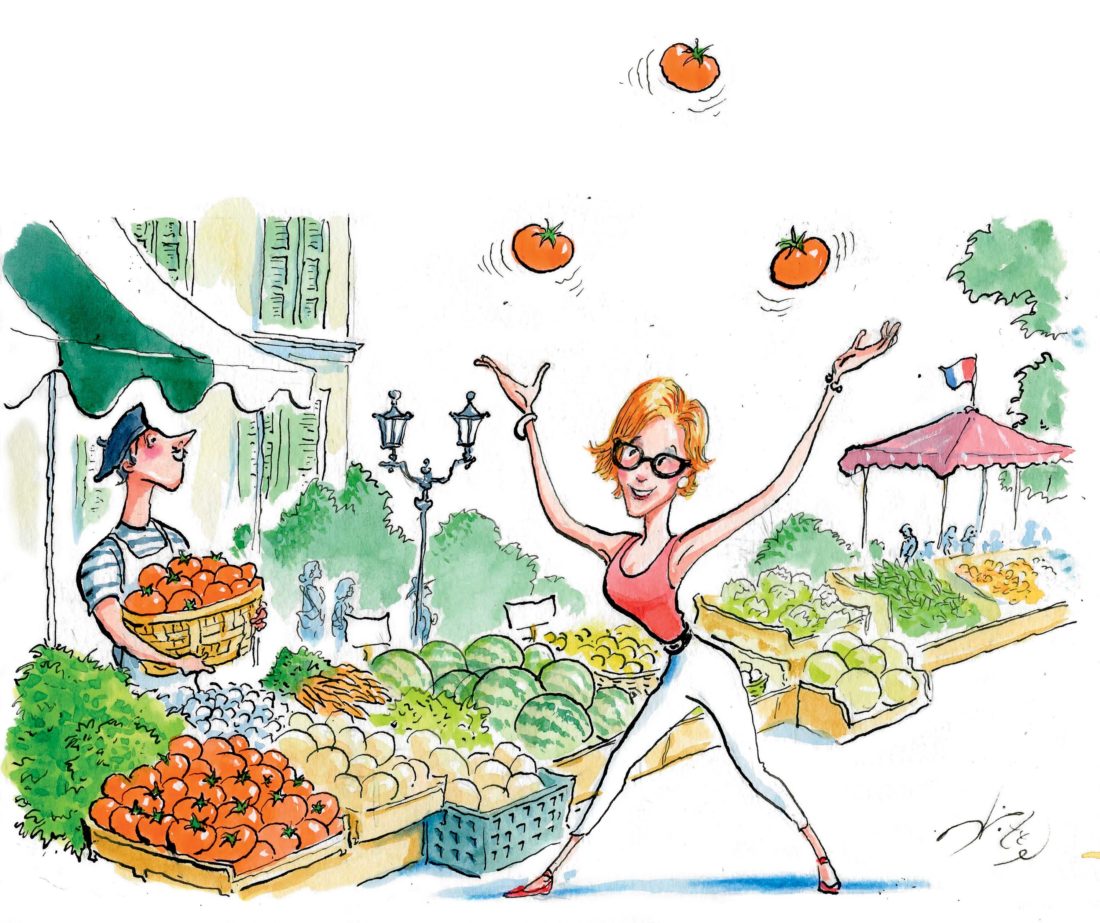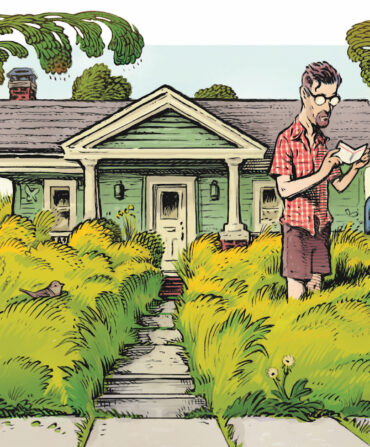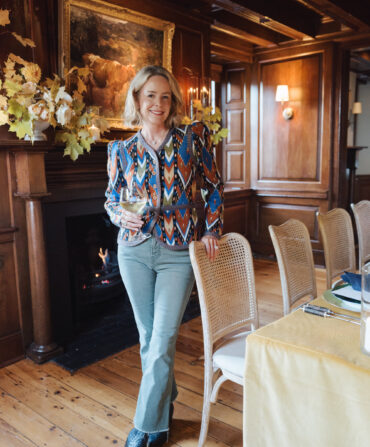I spent the second week of July in a lovely stone farmhouse in an equally lovely village in Provence called Vernègues. My dear, dear friends Ellen Stimson and John Rushing had rented the place and assembled an intimate but jolly house party made up of people like me who love to cook and eat and drink pastis and lie around reading books in the sun. On my first night, John, who knows more about music than pretty much anyone I know, got us tickets to a jazz festival in a nearby town where we sat beneath enormous plane trees, drinking large glasses of French beer and listening to Pat Metheny make such magical music on his guitar that we all cried, including Metheny himself. We also watched soccer and shared the whole country’s increasingly frenzied excitement as France got ever closer to winning the World Cup; we had a languorous lunch in Cassis (where I ate the most divine gratinéed mussels probably ever cooked and where we toured the majestic limestone calanques from a boat skippered by an impossibly adorable brown sea otter of a boy named Louis). Mostly, though, we shopped at nearby farmers’ markets and butchers and roadside stands and made lunches and dinners in the enormous kitchen carved out of a stone embankment and featuring a commodious oven and a fridge that held a constantly replenished supply of rosé.
As is invariably the case (with me and like-minded folks, at least), food—choosing it, handling it, cooking it, and, almost always, talking about it while eating it—triggers food memories. Just about every significant meal I’ve ever sat down to is marked in some way by recollections of or nostalgia for another. Because, as Proust so emphatically made the case with his madeleines, food is about much more than mere physical sustenance. Each taste or smell opens a doorway to one’s past, long buried or recent, and the memories bound up in each bite.
On my first trip to Provence, I stayed in a house rented by my late first cousin Frances, who was born a month before me and whom I loved more than I could any sister. I was living in Madrid that summer and had discovered pisto, a Spanish stew of zucchini and tomatoes more delicate than the French ratatouille and the specialty at the venerable Casa Paco. When it was my turn to cook, I made it for dinner with a tender leg of lamb and cherry clafouti for dessert. There was an enormous cherry tree in the backyard (along with two horses we rode bareback), and when we pitted the cherries before adding them to the batter, deep red juice flowed down all our arms. Images of that glorious evening almost twenty years earlier came flooding back as I stood this summer on a roadside near Mallemort, feeling the tomatoes and piling zucchini in my basket. There were insanely plump cherries too, and I had thought to pack a pitter in my suitcase.
Once again, I was in charge of the meal, so when we stopped at the boucherie on the way home, I bought skinny lamb chops and Spanish-style chorizo sausage, and then we all got to work in the kitchen. I chopped the vegetables for the pisto I’d decided to make after so long a time and marinated the chops in rosemary and garlic and lemon, an act that prompted yet another memory—of a lunch off the Adriatic coast of Italy. I was with a man who was beautiful to look at but also insecure and cruel, and we were making our way to Rome from a fancy resort where the food had been both forgettable and pretentious. The antidote appeared like a mirage as we came around an especially treacherous curve: a rustic restaurant filled with noisy families still dressed for church whose good humor and just plain goodness seemed palpable (though it was no doubt heightened in comparison with the disposition of my companion). Everyone around us was enjoying platters of crispy lamb chops, so we ordered them too, a pile of perfect bites fresh off the wood-fired grill, scented with rosemary and flavored with sizzling fat. To this day, the memory of them transcends that supremely ill-advised entanglement, and I attempted to re-create them for our own happy group in Vernègues. We never made the clafouti—the cherries were so good we ate them before we unpacked the rest of the groceries, standing in front of the deep copper sink.
Ellen had armed each of us on the trip with a copy of Provence, 1970, a wonderful book by Luke Barr that uses a moment in time when six iconic American culinary figures—including Richard Olney, Julia Child, and M.F.K. Fisher—found themselves together in the South of France, to chronicle the subsequent food revolution in America. Fisher is not just my favorite food writer, but my favorite memoirist, period, so I also brought along her lovely Long Ago in France, which I’ve probably read a half dozen times. In it, she recalls the year 1929, when she was a young wife having just moved to Dijon, where a favorite meal was a casserole of cauliflower, served with a salad and “cheap but good” red wine. She remembers the cauliflower, “small and very succulent, grown in that ancient soil,” which she boiled for a few minutes and covered in heavy cream and “a thick sprinkling of freshly grated Gruyère, the nice rubbery kind that didn’t come from Switzerland at all, but from the Jura…It was grated while you watched, in a soft cloudy pile, onto your piece of paper.” In the end, she and her guests “cleared [their] plates with bits of crisp bread crust and drank the wine,” and made big plans, but when she moved back to California, she found that she could never replicate the dish. The cauliflower was watery, the cream not thick enough or unpasteurized, the cheese dry and oily. But the ingredients weren’t the problem, not really: “Where was the crisp bread, where the honest wine? And where were our uncomplicated hungers, too?”
That’s the thing: Food is about not just where you are when you make it, but who you are. Some meals are tinged with joy or regret, some, like Fisher’s, with an innocence that can never be reclaimed. My own most memorable “innocent” feast was consumed yet again with Frances. We were in our early twenties, on holiday in Guadeloupe, nursing broken hearts. But we were young with what we thought was all the time in the world—the future was so spread out right in front of us that we couldn’t stay too sad, and anyway the setting was beautiful and the food delicious. One morning, we drove to the opposite side of the island to visit a rain forest, where I purposely ripped the seam running up the middle of my linen Calvin Klein skirt so I could hike to the top of an unexpected waterfall. Afterward, exhausted and famished, we drove along the cliff road and stopped at a tiny store for what we hoped would be a cold beer and maybe a bag of chips. Instead, the proprietor ushered us onto a hidden terrace overlooking the sea and sent a small boy scrambling down to spear a fish. The man stuffed the barely dead snapper with stalks of fresh thyme and threw it on a grill while he sautéed a pan of diced breadfruit with wild mushrooms. Frances, who hated fish, made do, tragically, with a heated can of Spaghetti-Os while I gulped cold white wine and dug into a bowl of homemade mango sorbet for dessert. When people ask me to name the best meal I’ve ever eaten, I almost always return to that one, while my friend Mary Thomas says hers is a plate of cornbread and sun-warmed sliced tomatoes with her maternal grandmother’s artichoke relish eaten in her childhood kitchen. Both could not be simpler or more vivid, touchstones suffused with memory to turn over again and again.
When I ask other folks about their favorite times at a table, most Yankees always tell me the name of a famous restaurant, not what they put in their mouths. I’ve had life-changing restaurant meals too, most notably at Le Bernardin when it was still in Paris. It was in 1984, and I was madly in love with a man whom I later, at the last minute, would decide not to marry, and I can still describe in painstaking detail the pounded raw tuna with chives placed before me and the salmon paillard in a garlic cream sauce that I wish more than anything I was eating right this minute. When the restaurant made the move to Manhattan two years later, it would change the way Americans thought about and prepared fish. On my first outing in its new home, I was given a plate of plump, lightly cooked oysters still in their shells and napped with truffled cream, a perfect marriage of earth and sea that moved me to tears. A very sweet French waiter, now retired, once told my dining companion, “We love it when she comes in here—she gets so emotional.” Well, yes. Food is emotion. When I talk about a food chain, I don’t mean Webster’s “arrangement of the organisms of an ecological community according to the order of predation in which each uses the next usually lower member as a food source.” I mean the chain of memories composed of single bites and whole meals and who we were and what was and might have been.
Herewith, I offer the very tangible and easily re-created pisto, with which I plan to make many more memories:
Casa Paco’s Pisto
Yield: 6 to 8 servings
INGREDIENTS
3 tbsp. olive oil
4 cloves minced garlic
2 chopped yellow onions
2 lb. zucchini, cut into half-inch cubes
2½ lb. ripe tomatoes, peeled, seeded, and chopped (or use 1½ large cans of whole peeled tomatoes, chopped)
½ tsp. sugar (or more, depending on the sweetness of the tomatoes)
1 tsp. salt
½ tsp. freshly ground pepper
2 large eggs, lightly beaten
PREPARATION
Heat the olive oil in a large skillet over medium heat. Add the garlic and onions and cook until soft, about 7 minutes, stirring frequently to make sure the garlic doesn’t burn. Stir in the zucchini, tomatoes, sugar, salt, and pepper. After about 5 minutes, add ¼ cup water and simmer, stirring often, mashing down on the vegetables as they soften. (A potato masher is useful.) Add more water if it cooks out before the vegetables are soft.
When the vegetables are done and the mixture resembles a chunky puree, taste and adjust the seasoning if necessary. Add the eggs, stirring quickly to incorporate, and remove from heat. Check for seasoning and serve hot or at room
temperature.








